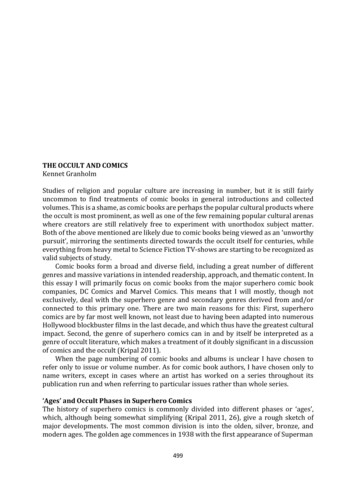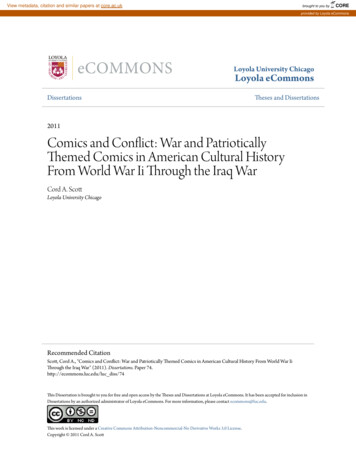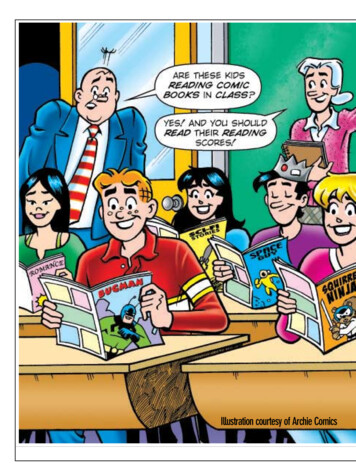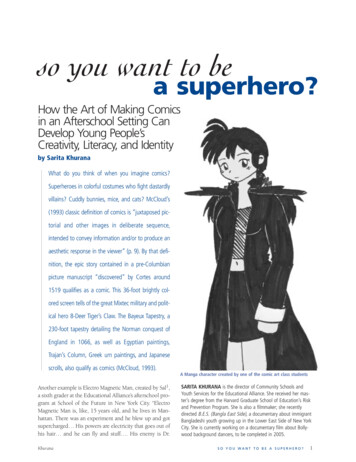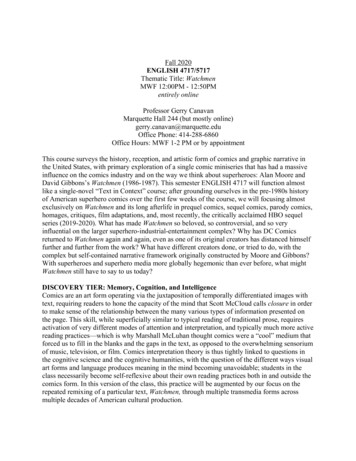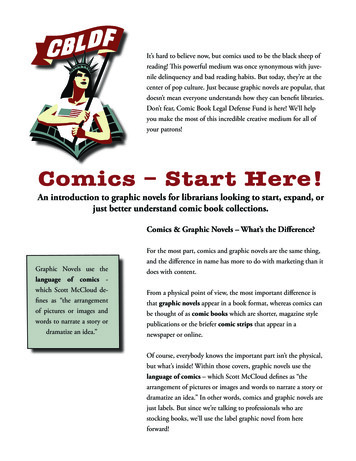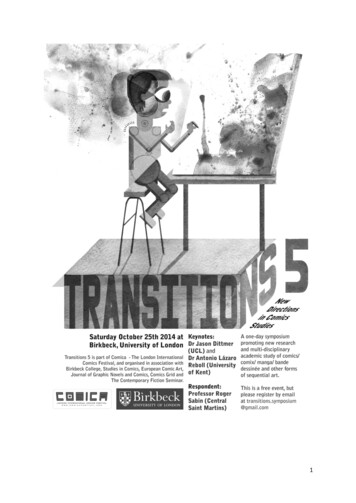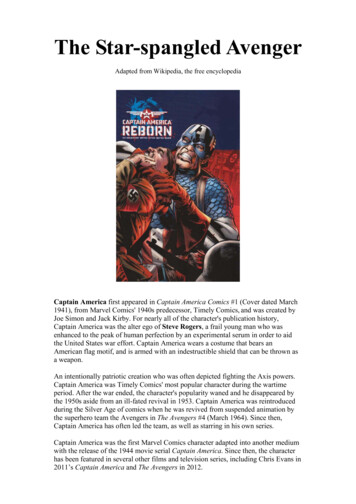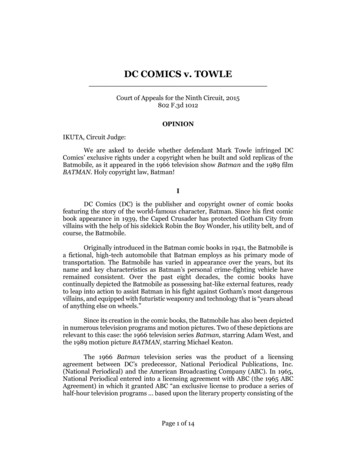
Transcription
DC COMICS v. TOWLECourt of Appeals for the Ninth Circuit, 2015802 F.3d 1012OPINIONIKUTA, Circuit Judge:We are asked to decide whether defendant Mark Towle infringed DCComics’ exclusive rights under a copyright when he built and sold replicas of theBatmobile, as it appeared in the 1966 television show Batman and the 1989 filmBATMAN. Holy copyright law, Batman!IDC Comics (DC) is the publisher and copyright owner of comic booksfeaturing the story of the world-famous character, Batman. Since his first comicbook appearance in 1939, the Caped Crusader has protected Gotham City fromvillains with the help of his sidekick Robin the Boy Wonder, his utility belt, and ofcourse, the Batmobile.Originally introduced in the Batman comic books in 1941, the Batmobile isa fictional, high-tech automobile that Batman employs as his primary mode oftransportation. The Batmobile has varied in appearance over the years, but itsname and key characteristics as Batman’s personal crime-fighting vehicle haveremained consistent. Over the past eight decades, the comic books havecontinually depicted the Batmobile as possessing bat-like external features, readyto leap into action to assist Batman in his fight against Gotham’s most dangerousvillains, and equipped with futuristic weaponry and technology that is “years aheadof anything else on wheels.”Since its creation in the comic books, the Batmobile has also been depictedin numerous television programs and motion pictures. Two of these depictions arerelevant to this case: the 1966 television series Batman, starring Adam West, andthe 1989 motion picture BATMAN, starring Michael Keaton.The 1966 Batman television series was the product of a licensingagreement between DC’s predecessor, National Periodical Publications, Inc.(National Periodical) and the American Broadcasting Company (ABC). In 1965,National Periodical entered into a licensing agreement with ABC (the 1965 ABCAgreement) in which it granted ABC “an exclusive license to produce a series ofhalf-hour television programs . based upon the literary property consisting of thePage 1 of 14
comic book and comic strip stories entitled ‘Batman’ . including the characterstherein.” This exclusive right included the right to “translate, adapt, [or] arrange”the Batman literary property “to such extent as ABC may desire” in the making ofthe television programs, and the right to secure copyrights in the televisionprograms produced. The agreement also provided that “[a]ll rights in the propertynot specifically granted to ABC are hereby reserved to and may be exercised byNational at all times during the term of this agreement” except as otherwiseexpressly stated in the agreement. National Periodical’s reserved rights included“[a]ll rights of publication,” and the exclusive merchandising rights to all productsmanufactured or distributed under the name of any character in the Batman comicbooks.Under this agreement, ABC (through a series of sub-licensing agreements)produced the 1966 television show starring Adam West as Batman. In addition toBatman, Robin, and the use of visual onomatopoeia that flashed on screen duringfight scenes—Pow! Boff! Thwack!—the television series featured the Batmobile.The design of the Batmobile did not directly copy any iterations of the Batmobileas it appeared in the comic books. As in the comic books, however, the Batmobilein the 1966 television show maintained a bat-like appearance and was equippedwith state-of-the-art weaponry and technology.1In 1979, DC again licensed its rights in the Batman literary property, thistime to Batman Productions, Inc. (BPI). In the agreement (the 1979 BPIAgreement), DC granted BPI the exclusive right to create a motion picture basedon the “Property,” which was defined to include “[t]he names, titles, fictionallocations and fictional conveyances . as depicted and contained in the comicmagazines [published by DC], which are identifiable with or associated with thefictional character known as ‘Batman,’ such as . that certain conveyance knownas the ‘Batmobile.’ ” The 1979 BPI Agreement also granted BPI the right to “adapt,use, . modify, [or] alter . the Property” for the purpose of producing the motionpicture. Like the 1965 ABC Agreement, the 1979 BPI Agreement provided that“[a]ll rights in the Property not specifically granted to” BPI under the agreement“are reserved to DC and may be exercised by DC at all times without any limitationor restriction whatsover except as specifically set forth herein.” These reservedrights included “[a]ll rights of publication in and to the Property,” as well as “[a]ll‘merchandising rights’ ” in “products manufactured or distributed under the nameof or using a representation of ‘Batman’ or any other character or thing includedin the Property . or under a name which incorporates any phrase, clause orexpression used in DC’s comic strips or comic magazines.”BPI subsequently sub-licensed its rights to Warner Bros., Inc., whoeventually (through a number of additional sub-licensing agreements) producedthe 1989 motion picture BATMAN, starring Michael Keaton as Batman. Like theA photo of the Batmobile depicted in the 1966 television series, as well as a photo ofTowle’s replica of this Batmobile, can be found in Appendix A.1Page 2 of 14
1966 television series, the 1989 motion picture featured a Batmobile that wasphysically distinct from the Batmobile portrayed in the comic books and the 1966television series. Nonetheless, the Batmobile as portrayed in the motion pictureretained a bat-like physical appearance and was again equipped with futuristictechnology and crime-fighting weaponry.2Defendant Mark Towle produces replicas of the Batmobile as it appearedin both the 1966 television show and 1989 motion picture as part of his business atGotham Garage, where he manufactures and sells replicas of automobiles featuredin motion pictures or television programs. Towle concedes that these replicas copythe designs of the Batmobile as depicted on television and in the motion picture,though they do not copy every feature. Towle then sells these vehicles forapproximately 90,000 to “avid car collectors” who “know the entire history of theBatmobile.” Towle also sells kits that allow customers to modify their cars to looklike the Batmobile, as it appeared in the 1966 television show and the 1989 motionpicture.Before DC brought this lawsuit, Towle advertised each replica as the“Batmobile,” and used the domain name batmobilereplicas.com to market hisbusiness. He also advertised that the replicas included such features as “custombat insignias, wheel bats, [and a] bat steering wheel,” and would attract attentiondue to the fame of the Batmobile. By his own admission, Towle is not authorizedby DC to manufacture or sell any products bearing DC’s copyright or trademark.In May 2011, DC filed this action against Towle, alleging, among otherthings, causes of action for copyright infringement, trademark infringement, andunfair competition arising from Towle’s manufacture and sale of the Batmobilereplicas.3 Towle denied that he had infringed upon DC’s copyright. He claimedthat the Batmobile as it appeared in the 1966 television show and 1989 motionpicture was not subject to copyright protection. Alternatively, Towle argued thatDC did not own the copyright in the Batmobile as it appeared in either production.Towle also asserted the affirmative defense of laches. The parties subsequentlyfiled cross motions for partial summary judgment as to DC’s trademark, copyright,and unfair competition claims, and as to Towle’s laches defense.In a published order, the district court granted in part and denied in partDC’s motion for summary judgment, and denied Towle’s cross motion forsummary judgment. DC Comics v. Towle, 989 F.Supp.2d 948 (C.D.Cal.2013).First, the district court held that the Batmobile was a character entitled toA photo of the Batmobile depicted in the 1989 motion picture, as well as a photo ofTowle’s replica of this Batmobile, can be found in Appendix B.3 DC clearly asserted in both its original and amended complaint that the Batmobile in allof its forms, including the 1966 television program and 1989 motion picture, iscopyrightable subject matter owned by DC. We thus reject Towle’s argument that DC hasfailed to identify the copyrights at issue in this case.2Page 3 of 14
copyright protection. In reaching this conclusion, the district court made a numberof findings. Among other things, it found that the Batmobile “is known by oneconsistent name that identifies it as Batman’s personal vehicle,” and, althoughsome of its physical traits have changed over time, several have remainedconsistent, including its “high-tech gadgets and weaponry,” “bat-like motifs,” andits jet black color. Additionally, the district court found that the Batmobile is always“depicted as being swift, cunning, strong and elusive,” and is even portrayed as a“superhero” and “Batman’s sidekick, if not an extension of Batman’s ownpersona.”4Second, the district court held that DC maintained a copyright in theBatmobile as it appeared in both the 1966 television show and the 1989 motionpicture based on its ownership of the merchandising rights. Alternatively, thedistrict court concluded that DC owns a copyright in the Batmobile as it appearedin each production because the appearance of the Batmobile in each productionwas derived from the Batmobile depicted in DC’s comic books. Finally, the districtcourt concluded that Towle infringed upon DC’s copyright because he copied theBatmobile as it appeared in the 1966 and 1989 productions in his replicas.Accordingly, the district court granted summary judgment on the copyrightinfringement claim to DC. .Finally, the court denied DC’s summary judgment motion on Towle’s lachesdefense to the copyright infringement claim because it determined that there wasa genuine dispute of fact as to whether Towle was aware that copying the Batmobileas it appeared in the 1966 television show and 1989 motion picture constitutedcopyright infringement.After the district court issued its decision, the parties entered into a jointstipulation in which they agreed that the district court would enter a judgmentagainst Towle on DC’s copyright infringement and other claims. They also agreedthat, except as provided in the stipulation, all claims were to be dismissed withprejudice. The district court entered a judgment consistent with this stipulation onFebruary 22, 2013, and Towle timely appealed.Because the parties entered into a stipulation that finalized the districtcourt order, we have jurisdiction over this appeal under 28 U.S.C. § 1291.The district court also concluded, in the alternative, that the 1966 and 1989 Batmobileswere entitled to copyright protection as a sculptural work under 17 U.S.C. § 102(a)(5).Because we agree that the Batmobile is a character entitled to copyright protection, we neednot reach this issue.4Page 4 of 14
IIIn order to prevail on its claim for copyright infringement, DC must provethat it owns a copyright in the Batmobile as it appeared in the 1966 television seriesand 1989 movie, and that Towle infringed that copyright by creating unauthorizedreplicas. See Entm’t Research Grp., Inc. v. Genesis Creative Grp., Inc., 122 F.3d1211, 1217 (9th Cir.1997).To the Batmobile!AWe begin with the question whether the Batmobile, as it appears in thecomic books, television series, and motion picture, is entitled to copyrightprotection. In the context of copyright law, where, as here, “the question requiresus to consider legal concepts in the mix of fact and law and to exercise judgmentabout the values that animate legal principles, . the question should be classifiedas one of law and reviewed de novo.” Harper House, Inc. v. Thomas Nelson, Inc.,889 F.2d 197, 201 (9th Cir.1989).Courts have recognized that copyright protection extends not only to anoriginal work as a whole, but also to “sufficiently distinctive” elements, like comicbook characters, contained within the work. Halicki Films, LLC v. Sanderson Sales& Mktg., 547 F.3d 1213, 1224 (9th Cir.2008). Although comic book characters arenot listed in the Copyright Act, we have long held that such characters are affordedcopyright protection. See Walt Disney Productions v. Air Pirates, 581 F.2d 751 (9thCir.1978). In Air Pirates, for instance, we considered a number of subversive comicbooks that portrayed well-known Disney characters as being active participants in“a free thinking, promiscuous, drug ingesting counterculture.” Id. at 753. Inholding that the Disney characters were copyrightable (and that Disney’s copyrightin those characters had been infringed), we distinguished a prior decisionsuggesting that literary “characters ordinarily are not copyrightable,” id. at 755(citing Warner Bros. Pictures, Inc. v. Columbia Broad. Sys., Inc., 216 F.2d 945(9th Cir.1954)), on the grounds that a comic book character “has physical as wellas conceptual qualities” and “is more likely to contain some unique elements ofexpression” than a purely literary character. Id. (citing Detective Comics, Inc. v.Bruns Publications Inc., 111 F.2d 432 (2d Cir.1940) (holding that comic bookcharacters are copyrightable); Fleischer Studios v. Freundlich, 73 F.2d 276 (2dCir.1934) (same); King Features Syndicate v. Fleischer, 299 F. 533 (2d Cir.1924)(same)). We subsequently held that characters in a television series or a motionpicture may also be entitled to copyright protection. See Olson v. NationalBroadcasting Co., 855 F.2d 1446 (9th Cir.1988).Not every comic book, television, or motion picture character is entitled tocopyright protection. We have held that copyright protection is available only “forPage 5 of 14
characters that are especially distinctive.” Halicki, 547 F.3d at 1224. To meet thisstandard, a character must be “sufficiently delineated” and display “consistent,widely identifiable traits.” Rice v. Fox Broadcasting Co., 330 F.3d 1170 (9thCir.2003) (citing Toho Co., Ltd. v. William Morrow & Co., Inc., 33 F.Supp.2d 1206,1215 (C.D.Cal.1998) (Godzilla)). A masked magician “dressed in standard magiciangarb” whose role “is limited to performing and revealing the magic tricks,” forexample, is not “an ‘especially distinct’ character differing from an ordinarymagician in a manner that warrants copyright protection.” Id. Further, charactersthat have been “lightly sketched” and lack descriptions may not merit copyrightprotection. Olson, 855 F.2d at 1452–53.We have previously determined that an automotive character can becopyrightable. See Halicki, 547 F.3d at 1224. In Halicki, we considered whether“Eleanor,” a car that appeared in both the original 1971 and 2000 remake motionpicture Gone in 60 Seconds, could be entitled to copyright protection as acharacter. Id. at 1224–25. Considering Eleanor’s persistent attributes in both theoriginal and remake of Gone in 60 Seconds, we concluded that Eleanor met someof the key factors necessary to qualify for copyright protection. Id. at 1225. We firstnoted that Eleanor was more like a comic book character than a literary charactergiven Eleanor’s “physical as well as conceptual qualities.” Id. We also stated thatEleanor “displays consistent, widely identifiable traits and is especiallydistinctive.” Id. (alteration, citation, and internal quotation marks omitted). Wegave several examples of these traits. First, we noted that “[i]n both films, the theftsof the other cars go largely as planned, but whenever the main human charactertries to steal Eleanor, circumstances invariably become complicated.” Id. Second,we noted that in the original, “the main character says ‘I’m getting tired of stealingthis Eleanor car,’ ” and in the remake “the main character refers to his history withEleanor.” Id. Despite this evidence of distinctive traits, we were sensitive to the factthat the district court had implied that Eleanor was deserving of copyrightprotection, but had not directly examined this “fact-intensive issue.” Id. Therefore,we remanded the issue to the district court to decide in the first instance. Id.As indicated in Halicki, a character may be protectable if it has distinctivecharacter traits and attributes, even if the character does not maintain the samephysical appearance in every context. As the Eighth Circuit has recognized, “thepresence of distinctive qualities apart from visual appearance can diminish or evennegate the need for consistent visual appearance.” Warner Bros. Entm’t, Inc. v. XOne X Prods., 644 F.3d 584, 599 n. 8 (8th Cir.2011). For example, in Halicki,Eleanor’s ability to consistently disrupt heists by her presence was more pertinentto our analysis of whether the car should qualify as a sufficiently distinctivecharacter than Eleanor’s make and model. 547 F.3d at 1225. Indeed, Halicki putno weight on the fact that Eleanor was a customized yellow 1971 Fastback FordMustang in one film, and a silver 1967 Shelby GT–500 in another.Similarly, district courts have determined that James Bond, Batman, andGodzilla are characters protected by copyright, despite their changes inPage 6 of 14
appearance. See Metro–Goldwyn–Mayer, Inc. v. Am. Honda Motor Co., 900F.Supp. 1287, 1295–96 (C.D.Cal.1995) (James Bond) (cited with approval in Rice); Toho Co. v. William Morrow & Co., 33 F.Supp.2d 1206, 1216 (C.D.Cal.1998)(Godzilla) (cited with approval in Rice ); Sapon v. DC Comics, No. 00 CIV.8992(WHP), 2002 WL 485730, at *3–4 (S.D.N.Y. Mar. 29, 2002) (Batman). Ineach instance, courts have deemed the persistence of a character’s traits andattributes to be key to determining whether the character qualifies for copyrightprotection. The character “James Bond” qualifies for copyright protection because,no matter what the actor who portrays this character looks like, James Bond alwaysmaintains his “cold-bloodedness; his overt sexuality; his love of martinis ‘shaken,not stirred;’ his marksmanship; his ‘license to kill’ and use of guns; his physicalstrength; [and] his sophistication.” Metro–Goldwyn–Mayer, 900 F.Supp. at 1296.Similarly, while the character “Godzilla” may have a different appearance fromtime to time, it is entitled to copyright protection because it “is always a prehistoric, fire-breathing, gigantic dinosaur alive and well in the modern world.”Toho Co., 33 F.Supp.2d at 1216. In short, although James Bond’s, Godzilla’s, andBatman’s “costume and character have evolved over the years, [they have] retainedunique, protectable characteristics” and are therefore entitled to copyrightprotection as characters. Sapon, 2002 WL 485730, at *3–4.We read these precedents as establishing a three-part test for determiningwhether a character in a comic book, television program, or motion picture isentitled to copyright protection. First, the character must generally have “physicalas well as conceptual qualities.” Air Pirates, 581 F.2d at 755. Second, the charactermust be “sufficiently delineated” to be recognizable as the same characterwhenever it appears. See Rice, 330 F.3d at 1175. Considering the character as it hasappeared in different productions, it must display consistent, identifiablecharacter traits and attributes, although the character need not have a consistentappearance. See Halicki, 547 F.3d at 1224. Third, the character must be “especiallydistinctive” and “contain some unique elements of expression.” Halicki, 547 F.3dat 1224. It cannot be a stock character such as a magician in standard magiciangarb. Rice, 330 F.3d at 1175. Even when a character lacks sentient attributes anddoes not speak (like a car), it can be a protectable character if it meets thisstandard. Halicki, 547 F.3d at 1224.We now apply this framework to this case. Because (unlike in Halicki ) thedistrict court here addressed this question in detail, we consider its factual findingsin analyzing this issue. Cf. Halicki, 547 F.3d at 1225. First, because the Batmobilehas appeared graphically in comic books, and as a three-dimensional car intelevision series and motion pictures, it has “physical as well as conceptualqualities,” and is thus not a mere literary character. Air Pirates, 581 F.2d at 755.Second, the Batmobile is “sufficiently delineated” to be recognizable as thesame character whenever it appears. See Rice, 330 F.3d at 1175. As the districtcourt determined, the Batmobile has maintained distinct physical and conceptualqualities since its first appearance in the comic books in 1941. In addition to itsPage 7 of 14
status as “a highly-interactive vehicle, equipped with high-tech gadgets andweaponry used to aid Batman in fighting crime,” the Batmobile is almost alwaysbat-like in appearance, with a bat-themed front end, bat wings extending from thetop or back of the car, exaggerated fenders, a curved windshield, and bat emblemson the vehicle. This bat-like appearance has been a consistent theme throughoutthe comic books, television series, and motion picture, even though the precisenature of the bat-like characteristics have changed from time to time.The Batmobile also has consistent character traits and attributes. Nomatter its specific physical appearance, the Batmobile is a “crime-fighting” car withsleek and powerful characteristics that allow Batman to maneuver quickly while hefights villains. In the comic books, the Batmobile is described as waiting “[l]ike animpatient steed straining at the reins . shiver[ing] as its super-charged motorthrobs with energy” before it “tears after the fleeing hoodlums” an instant later.Elsewhere, the Batmobile “leaps away and tears up the street like a cyclone,” andat one point “twin jets of flame flash out with thunderclap force, and the miraclecar of the dynamic duo literally flies through the air!”66 Like its comic bookcounterpart, the Batmobile depicted in both the 1966 television series and the 1989motion picture possesses “jet engine[s]” and flame-shooting tubes thatundoubtedly give the Batmobile far more power than an ordinary car.Furthermore, the Batmobile has an ability to maneuver that far exceeds that of anordinary car. In the 1966 television series, the Batmobile can perform an“emergency bat turn” via reverse thrust rockets. Likewise, in the 1989 motionpicture, the Batmobile can enter “Batmissile” mode, in which the Batmobile sheds“all material outside [the] central fuselage” and reconfigures its “wheels and axlesto fit through narrow openings.”7Equally important, the Batmobile always contains the most up-to-dateweaponry and technology. At various points in the comic book, the Batmobilecontains a “hot-line phone . directly to Commissioner Gordon’s office”maintained within the dashboard compartment, a “special alarm” that foils theJoker’s attempt to steal the Batmobile, and even a complete “mobile crime lab”within the vehicle. Likewise, the Batmobile in the 1966 television series possessesa “Bing–Bong warning bell,” a mobile Bat-phone, a “Batscope, complete with [a]TV-like viewing screen on the dash,” and a “Bat-ray.” Similarly, the Batmobile inthe 1989 motion picture is equipped with a “pair of forward-facing Browningmachine guns,” “spherical bombs,” “chassis-mounted shinbreakers,” and “sidemounted disc launchers.”Because the Batmobile, as it appears in the comic books as well as in the1966 television show and 1989 motion picture, displays “consistent, identifiablecharacter traits and attributes,” the second prong of the character analysis is methere.67This episode causes Robin to exclaim “Whee! The Batplane couldn’t do better!”Towle submitted a chart to the district court setting forth these features.Page 8 of 14
Third, the Batmobile is “especially distinctive” and contains uniqueelements of expression. In addition to its status as Batman’s loyal bat-themedsidekick complete with the character traits and physical characteristics describedabove, the Batmobile also has its unique and highly recognizable name. It is notmerely a stock character.Accordingly, applying our three-part test, we conclude that the Batmobileis a character that qualifies for copyright protection.Towle raises two arguments against this conclusion. First, he points outthat the Batmobile has at times appeared without its signature sleek “bat-like”features. He notes that in a 1988 comic book rendition, the Batmobile appears asa heavily armored tank with large tires and a rocket launcher. The Batmobileportrayed in the 1989 motion picture could also transform into a Batmissile. As wehave noted, however, a consistent appearance is not as significant in our analysisas consistent character traits and attributes. The changes in appearance cited byTowle resemble costume changes that do not alter the Batmobile’s innatecharacteristics, any more than James Bond’s change from blue swimming trunks(in Casino Royale ) to his classic tuxedo affects his iconic character. In context, thedepictions of the Batmobile as a tank or missile promote its character as Batman’scrime-fighting super car that can adapt to new situations as may be necessary tohelp Batman vanquish Gotham City’s most notorious evildoers. See Halicki, 547F.3d at 1224–25.Second, Towle argues that a jury should decide the question whether theBatmobile displayed unique elements of expression and consistent, widelyidentifiable traits. We disagree. We have previously recognized that “[w]hether aparticular work is subject to copyright protection is a mixed question of fact andlaw subject to de novo review.” Societe Civile Succession Guino v. Renoir, 549 F.3d1182, 1185 (9th Cir.2008). Neither party disputes the relevant facts regarding theBatmobile here. Accordingly, we are well-equipped to determine whether, as amatter of law, these undisputed facts establish that the Batmobile is an “especiallydistinctive” character entitled to copyright protection.BHaving concluded that the Batmobile is a copyrightable character, we nextconsider whether Towle’s copies of the Batmobile as it appeared in the 1966 and1989 productions infringed on DC’s copyright. Here, Towle does not contest thathis replicas copy the Batmobile as it appeared in the 1966 and 1989 productions,even if they do not copy every feature. Rather, Towle’s main argument is that DCdoes not own any copyright interest in the 1966 and 1989 productions andtherefore lacks standing to pursue its copyright infringement claim against Towle.To analyze Towle’s argument, we begin with the applicable legalPage 9 of 14
framework. Under the Copyright Act, “copyright ownership ‘vests initially in theauthor or authors of the work,’ which is generally the creator of the copyrightedwork.” U.S. Auto Parts Network, Inc. v. Parts Geek, LLC, 692 F.3d 1009, 1015 (9thCir.2012) (quoting 17 U.S.C. § 201(a)). The owner of a copyright has a number ofexclusive rights, including the right “to prepare derivative works” based on itsoriginal work of authorship, 17 U.S.C. § 106. A derivative work is a “work basedupon one or more preexisting works that recasts, transforms, or adapts thepreexisting work,” Parts Geek, 692 F.3d at 1015–16 (alterations omitted) (quoting17 U.S.C. § 101), such as a motion picture that is based on a literary work, see, e.g.,Stewart v. Abend, 495 U.S. 207, 212–14 (1990), a three-dimensional costumebased upon two-dimensional cartoon characters, see Entm’t Research Grp., 122F.3d at 1218, or three-dimensional figurines based on cartoon characters, DurhamIndus., Inc. v. Tomy Corp., 630 F.2d 905, 909 (2nd Cir.1980). If an unauthorizedthird party prepares a derivative work, the copyright owner of the underlying workcan sue for infringement. See Silvers v. Sony Pictures Entm’t, Inc., 402 F.3d 881,885 (9th Cir.2005) (en banc) (citing 17 U.S.C. § 501(b)); see also, e.g., Air Pirates,581 F.2d at 754–55; Durham Indus., 630 F.2d at 909.A copyright owner also has the exclusive right to “authorize others toprepare derivative works based on their copyrighted works.” Lewis Galoob Toys,Inc. v. Nintendo of Am., Inc., 964 F.2d 965, 967 (9th Cir.1992). When a copyrightowner authorizes a third party to prepare a derivative work, the owner of theunderlying work retains a copyright in that derivative work with respect to all ofthe elements that the derivative creator drew from the underlying work andemployed in the derivative work. See Stewart, 495 U.S. at 223. By contrast, thecreator of the derivative work has a copyright only as to those original aspects ofthe work that the derivative creator contributed, and only to the extent thederivative creator’s contributions are “more than trivial.” Parts Geek, 692 F.3d at1016; see also Stewart, 495 U.S. at 223. Moreover, a copyright in a derivative work“must not in any way affect the scope of any copyright protection in that preexistingmaterial.” Id.; see 17 U.S.C. § 103(a) (“The copyright in a . derivative work . isindependent of, and does not affect or enlarge the scope, duration, ownership, orsubsistence of, any copyright protection in the preexisting material.”). Logically,therefore, if a third party copies a derivative work without authorization, itinfringes the original copyright owner’s copyright in the underlying work to theextent the unauthorized copy of the derivative work also copies the underlyingwork. .In sum, as a leading copyright commentator explained, “if the materialcopied was derived from a copyrighted underlying work, this will constitute aninfringement of such work regardless of whether the defendant copied directlyfrom the underlying work, or indirectly via the derivative work.” 1 Melville B.Nimmer & David Nimmer, Nimmer on Copyright § 3.05, at 3–34.31 (MatthewBender, Rev. Ed.) (hereafter Nimmer on Copyright ). This conclusion is consistentPage 10 of 14
with our determination that a copyright in an authorized derivative work “mustnot in any way affect the scope of any copyright protection in” the underlying work.Parts Geek, 692 F.3d at 1016 (quoting Entm’t Research Grp., 122 F.3d at 1220(quoting Durham Indus., 630 F.2d at 909)). Accordingly, the author of anunderlying work is entit
Comics’ exclusive rights under a copyright when he built and sold replicas of the Batmobile, as it appeared in the 1966 television show Batman and the 1989 film BATMAN. Holy copyright law, Batman! I DC Comics (DC) is the publisher and copyright owner of comic books featuring the stor

